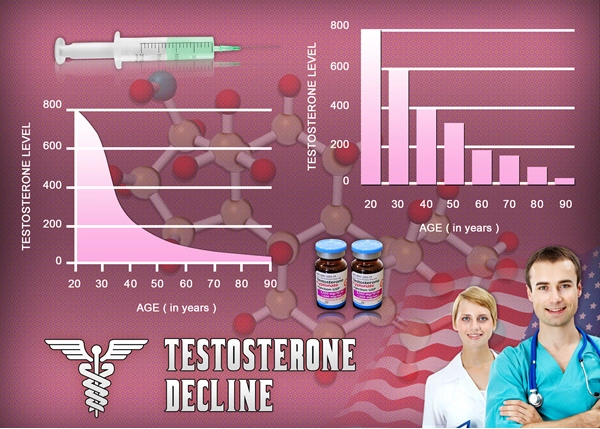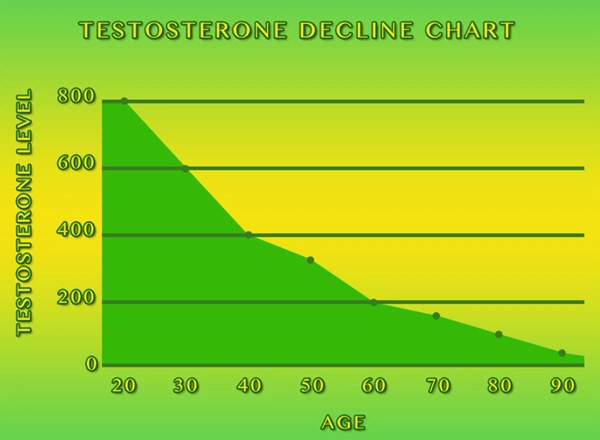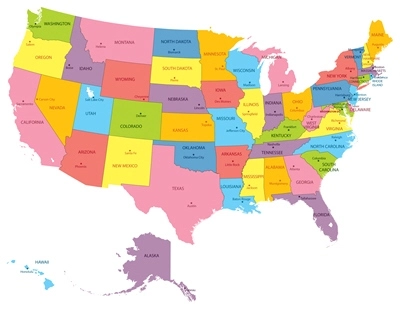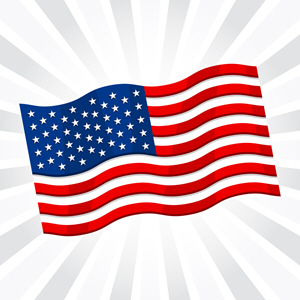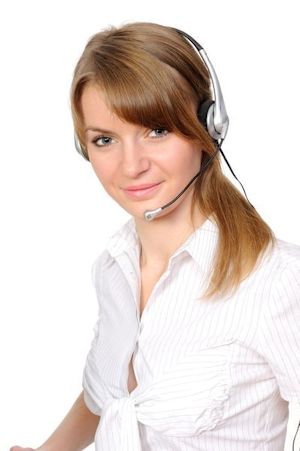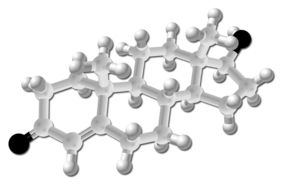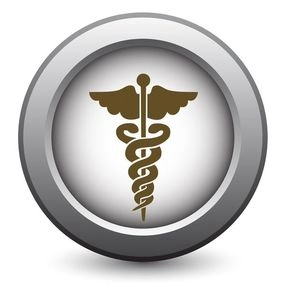If you had asked a doctor 10 years ago about bumping testosterone into the high-normal range to enhance one's physique, chances are slim you would have gotten a positive response. "Testosterone is bad for you," he would probably say. "It will shrink your grapes to raisins, give you liver disease and make you backhand your Grandma!"
Enter 1996 and the legal availability of androstenedione (a-dione) and other prohormones. For the first time, "steroids" were legally available over the counter and testosterone became user-friendly. It could not only enhance strength and muscle size, but also improve body composition, bone density, libido, and immunocompetence. Some research even suggested T could make you smarter! Unfortunately, as supplement sales skyrocketed, so did marketing hyperbole. And so, too, did the bull about which company had the most potent prohormone concoction and how effective these "legal steroids" were.
If you are tired of being confused by "diones", "diols" and "19-nor" something-or-others - and want to know the real benefits and risks associated with testosterone boosting - read on. The information presented may just clear some of that fog in your noggin'.
Testosterone is a 19-carbon steroid hormone produced primarily by the Leydig cells of the testes (in men) and the ovaries (in women). Smaller amounts are produced in the adrenal glands of both sexes. As a "steroid", testosterone belongs to the androgen class of hormones that also includes dihydrotestosterone (DHT), dehydroepiandrosterone (DHEA), androstenedione, and androstenediol. Six other classes of steroid hormones exist, including estrogens (the bane of male bodybuilders), progestins (some female contraceptives are made of these), mineralocorticoids (which help control water balance), glucocorticoids (mainly anti-inflammatory compounds), vitamin D, and bile acids.
In men, approximately seven mg of testosterone is produced each day, and blood levels range between 300 and 1000 ng/dL (10-28 nmol/L). Females, on the other hand, produce about 1/15th of this amount, leading to average blood levels of only 25 to 90 ng/dL (1-2.5 nmol/L). All steroid hormones are derived from the sterane ring structure, composed of three hexane (6 carbon) rings and one pentane (5 carbon) ring.
In healthy humans, the "rate-limiting" step in testosterone biosynthesis is the conversion of cholesterol into a hormone called pregnenolone. This hormone is then first converted to either DHEA or progesterone before being further degraded in a stepwise fashion to testosterone. Schematically, the two possible pathways look like this: (Enzymes have been omitted for clarity.)
Cholesterol pregnenolone progesterone androstenedione T Cholesterol pregnenolone DHEA androstenediol T
After testosterone is secreted into the bloodstream, 96-98 percent is bound to proteins called albumin and globulin. This binding is thought to serve three purposes: 1) it makes testosterone soluble for transport within the blood, 2) it protects testosterone from degradation by the liver and kidneys, and 3) it serves as a reservoir or storage depot that can be used to dampen fluctuations in plasma testosterone.
The two to four percent not bound to plasma proteins is known as "free testosterone" and is thought to represent the biologically active fraction of the hormone; in other words, the amount that is capable of interacting with cells to cause physiological changes. And although recent data suggest this is most likely an oversimplification, we'll leave that discussion for another time.
Regulation of testosterone levels is governed by two factors: the total amount of testosterone in the blood, and the binding capacity of the plasma proteins. Obviously, as binding capacity goes up blood levels of free testosterone go down. Not surprisingly, certain drugs (anabolic-androgenic steroids, insulin, etc.) and perhaps nutritional supplements (like avena sativa, urtica dioica, etc.) can reduce the binding capacity of the blood and result in higher free-testosterone levels. (Editors' Note: Nutrition is also a factor in testosterone regulation; see our March discussion on this topic in Experiments vs. Experience.)
There is also mounting evidence that some types of pollution and pesticides can do the opposite. So much for running sprints in downtown Detroit! Also, testosterone production from the testes occurs the entire period of fetal development until about 10 weeks after birth. Then the gears screech to a stop until puberty - a time when men know all-too well their T levels are screaming.
This is a time when young men really blow past their female counterparts in body weight and muscularity - and get drawn toward sports like high school football, along with other aggressive pastimes. Sadly in many ways, testosterone levels begin to decline between the third and fourth decade of life. And by 80 (if we make it that long) we are only one-third the man we used to be, testosterone-wise.
The physiological actions of testosterone in males are far reaching. For example:
Note: This list is meant to be illustrative rather than exhaustive. Testosterone has other effects on the body that are not listed.
Of the "free" testosterone that interacts at the tissue level, much of it is converted within the cells to DHT - a more potent androgen - by the enzyme 5-alpha reductase. In the prostate, for example, this conversion is thought to be necessary for physiologic effects. Other tissues (like the epididymis, vas deferens, seminal vesicles, skeletal muscle, and bone) lack the 5-alpha reductase enzyme and therefore are thought to respond to testosterone directly.
The conversion of testosterone into estrogens (estriol, estrone and estradiol) is governed by the aromatase enzyme complex and occurs mainly in the liver, brain and fat tissue. Some bodybuilders attempt to avoid / reduce the conversion of testosterone to DHT or estrogens by maintaining low bodyfat and using drugs or nutritional supplements that block 5-alpha reductase and aromatase. Chrysin, saw palmetto and indole-3-carbinol are three examples of legal plant-derived supplements that may maximize testosterone levels by minimizing its conversion to DHT and estrogens. Unfortunately, the bio-availability of many "bioflavanoid" compounds when ingested is poor. Some cutting-edge supplement companies have trick "delivery systems" that attempt to address this problem.
It is important to recognize that blood levels of testosterone - all hormones for that matter - represent a dynamic balance between biosynthesis (which occurs in a pulsatile fashion) and biodegradation. As mentioned, the testes, adrenals and ovaries are responsible for testosterone biosynthesis, while the liver and kidneys are responsible for its biological degradation and excretion. So, for instance, increases in plasma testosterone commonly observed following a hard weight-training session are not just the result of increased production of testosterone from the testes, but also from a reduction in its clearance (blood flow to the liver and kidneys is reduced during exercise). Make sense?
This balance between synthesis and breakdown also make a single blood testosterone value extremely difficult to interpret. As noted decades ago, testosterone levels rise and fall throughout the day; therefore a single testosterone value could represent a peak or valley on the daily testosterone roller coaster.
So what is the difference between testosterone and anabolic-androgenic steroids (AAS)? Well, while testosterone is produced naturally in the body, AAS are synthetic analogs of testosterone that were first used medically in the US around the time My Three Sons and The Honeymooners were beaming with popularity.
By synthetic, I mean AAS are synthesized by guys in lab coats who, for most of their lives, have been taking science and chemistry courses. Several "relatively safe" AAS are used clinically to treat osteoporosis and muscle-wasting disorders. These are nandrolone decanoate (Deca Durabolin) and oxandrolone (Anavar), respectively. Examples of more potent, but potentially dangerous, AAS are fluoxymesterone (Halotestin), trenbolone acetate (Parabolan), methandrostenolone (Dianabol), and oxymetholone (Anadrol). In general, injectable steroids are more potent, safer and remain in the system longer than oral steroids. There are, however, a few exceptions.
Though you may already be aware of potential side effects from testosterone abuse (note I said abuse and not use), here they are again: lowered HDL-cholesterol levels (good cholesterol), testicular atrophy, reductions in sperm count, prostate enlargement, liver damage (primarily with oral steroids that have been modified with a 17-alkyl substitution), menstrual irregularities, suppression of endogenous hormone levels (like LH and T), development of palpable breast tissue in men (also known as gynecomastia), clitoral enlargement, and acne.
Whether an individual using AAS will develop any of these side effects is difficult to predict because of the complex interaction between factors like drug type, dosage, duration of use, and individual (genetic) differences. Suffice to say there are safer ways to boost testosterone levels and gain an edge in the gym. More importantly, there are legal ways - at least for now.
More here:
All About Testosterone! - Bodybuilding.com
Contact Us Today For A Free Consultation

- Adverse Effects of Testosterone Therapy in Adult Men: A Systematic Review and Meta-Analysis [Last Updated On: July 2nd, 2024] [Originally Added On: June 4th, 2010]
- Low Testosterone Levels, Foods That Increase Testosterone Levels wwwSelf-Improvement-Bible.com [Last Updated On: November 12th, 2023] [Originally Added On: May 30th, 2011]
- Low Testosterone in Men: The Next Big Thing in Medicine! - Abraham Morgentaler, MD [Last Updated On: May 7th, 2023] [Originally Added On: June 3rd, 2011]
- How To Determine Testosterone Levels By Looking At Your Ring Finger [Last Updated On: December 7th, 2017] [Originally Added On: June 30th, 2011]
- Prolab Horny Goat Weed Testosterone Booster Supplement Review [Last Updated On: November 23rd, 2023] [Originally Added On: July 19th, 2011]
- The Healthy Skeptic: Products make testosterone claims [Last Updated On: August 13th, 2024] [Originally Added On: September 11th, 2011]
- How To Naturally Increase Testosterone [Last Updated On: November 21st, 2023] [Originally Added On: September 28th, 2011]
- Testosterone Production - Video [Last Updated On: November 25th, 2024] [Originally Added On: November 20th, 2011]
- Testosterone makes us less cooperative and more egocentric, study finds [Last Updated On: January 23rd, 2018] [Originally Added On: February 1st, 2012]
- Testosterone makes us less cooperative and more egocentric [Last Updated On: January 24th, 2018] [Originally Added On: February 1st, 2012]
- Too much testosterone makes for bad decisions, tests show [Last Updated On: April 30th, 2025] [Originally Added On: February 1st, 2012]
- Today in Research: Testosterone's Negative Effects; Diet Soda Death [Last Updated On: January 2nd, 2018] [Originally Added On: February 2nd, 2012]
- Testosterone drives ego, trips cooperation [Last Updated On: December 2nd, 2017] [Originally Added On: February 4th, 2012]
- FDA approves BioSante/Teva's testosterone gel [Last Updated On: April 28th, 2025] [Originally Added On: February 15th, 2012]
- 'Manly' Fingers Make For Strong Jawline in Young Boys [Last Updated On: December 1st, 2017] [Originally Added On: February 15th, 2012]
- Teva, BioSante Win U.S. Approval for Testosterone Therapy [Last Updated On: December 10th, 2017] [Originally Added On: February 15th, 2012]
- BioSante Gains on Approval of Testosterone Gel: Chicago Mover [Last Updated On: January 8th, 2018] [Originally Added On: February 16th, 2012]
- BioSante soars following drug approval from FDA [Last Updated On: December 26th, 2017] [Originally Added On: February 16th, 2012]
- Antibodies, Not Hard Bodies: The Real Reason Women Drool Over Brad Pitt [Last Updated On: December 24th, 2017] [Originally Added On: February 21st, 2012]
- Almark Publishing Releases Book From Mark Rosenberg, M.D. Revealing Natural Discoveries Associated With Low ... [Last Updated On: May 3rd, 2025] [Originally Added On: February 28th, 2012]
- Testosterone Replacement Clinic Comes to Kansas City with Potential to Help Thousands of Men [Last Updated On: May 2nd, 2025] [Originally Added On: March 1st, 2012]
- Study examines the relative roles of testosterone and its metabolite, dihydrotestosterone in men [Last Updated On: December 2nd, 2017] [Originally Added On: March 7th, 2012]
- The Role of 5{alpha}-Reductase Inhibition in Men Receiving Testosterone Replacement Therapy [Editorial] [Last Updated On: December 21st, 2017] [Originally Added On: March 7th, 2012]
- Effect of Testosterone Supplementation With and Without a Dual 5{alpha}-Reductase Inhibitor on Fat-Free Mass in Men ... [Last Updated On: January 3rd, 2018] [Originally Added On: March 7th, 2012]
- Why We Like Men Who Can Keep Their Cool [Last Updated On: December 30th, 2017] [Originally Added On: March 7th, 2012]
- Testosterone And Heart Health [Last Updated On: May 1st, 2025] [Originally Added On: March 10th, 2012]
- Your Life on Testosterone: Overly Sure of Yourself, Unwilling to Listen [Last Updated On: November 25th, 2018] [Originally Added On: March 15th, 2012]
- Mayo Clinic-TGen study role testosterone may play in triple negative breast cancer [Last Updated On: December 8th, 2017] [Originally Added On: March 23rd, 2012]
- A dose of testosterone might not cure what ails you [Last Updated On: January 23rd, 2018] [Originally Added On: March 25th, 2012]
- Green tea could aid athletes hide testosterone doping [Last Updated On: December 16th, 2017] [Originally Added On: March 25th, 2012]
- TGen Study Role Testosterone May Play in Triple Negative Breast Cancer [Last Updated On: December 6th, 2017] [Originally Added On: March 26th, 2012]
- Testosterone low, but responsive to competition, in Amazonian tribe [Last Updated On: January 23rd, 2018] [Originally Added On: March 28th, 2012]
- Competition-linked bursts of testosterone are fundamental aspect of human biology, study of Amazonian tribe suggests [Last Updated On: December 25th, 2017] [Originally Added On: March 28th, 2012]
- Playing football boosts testosterone levels by 30 percent! [Last Updated On: February 4th, 2024] [Originally Added On: March 28th, 2012]
- Testosterone low, but responsive to competition, in Amazonian tribe -- with slideshow [Last Updated On: December 9th, 2017] [Originally Added On: March 28th, 2012]
- The benefits of testosterone pellet therapy [Last Updated On: January 24th, 2018] [Originally Added On: March 29th, 2012]
- Low testosterone levels cause health woes [Last Updated On: November 25th, 2018] [Originally Added On: March 30th, 2012]
- Heart Failure Patients Getting Relief from Testosterone Supplements [Last Updated On: May 5th, 2025] [Originally Added On: April 21st, 2012]
- Study Finds Fatherhood Suppresses Testosterone [Last Updated On: May 4th, 2025] [Originally Added On: May 3rd, 2012]
- Low testosterone levels could raise diabetes risk for men [Last Updated On: January 26th, 2018] [Originally Added On: May 5th, 2012]
- Why low testosterone may increase your risk of diabetes [Last Updated On: November 25th, 2024] [Originally Added On: May 5th, 2012]
- Diabetes link to low testosterone [Last Updated On: November 25th, 2024] [Originally Added On: May 5th, 2012]
- Testosterone Linked to Weight Loss in Obese Men [Last Updated On: January 2nd, 2018] [Originally Added On: May 11th, 2012]
- Testosterone may help weight loss [Last Updated On: November 25th, 2024] [Originally Added On: May 11th, 2012]
- Testosterone-fuelled infantile males might be a product of Mom's behaviour [Last Updated On: December 25th, 2017] [Originally Added On: May 11th, 2012]
- Testosterone-fueled infantile males might be a product of Mom's behavior [Last Updated On: January 6th, 2018] [Originally Added On: May 11th, 2012]
- Testosterone supplements may help obese men lose weight [Last Updated On: January 5th, 2018] [Originally Added On: May 11th, 2012]
- Testosterone supplements 'can help men lose their middle-aged spread' [Last Updated On: November 25th, 2024] [Originally Added On: May 12th, 2012]
- Some doctors question safety of testosterone replacement therapy [Last Updated On: January 20th, 2018] [Originally Added On: May 15th, 2012]
- Health Canada Approves New Testosterone Topical Solution for Men [Last Updated On: May 15th, 2025] [Originally Added On: May 15th, 2012]
- Environment trumps genes in testosterone levels, study finds [Last Updated On: May 8th, 2025] [Originally Added On: May 15th, 2012]
- Global Testosterone Replacement Therapy (TRT) Industry [Last Updated On: May 7th, 2025] [Originally Added On: May 21st, 2012]
- Testosterone Fuels Boom, Swindler Sows Panic: Top Business Books [Last Updated On: January 13th, 2018] [Originally Added On: June 2nd, 2012]
- Increase in testosterone drug use [Last Updated On: April 12th, 2018] [Originally Added On: June 4th, 2012]
- Testosterone Promotes Agression Automatically [Last Updated On: January 29th, 2018] [Originally Added On: June 9th, 2012]
- Testosterone shown to help sexually frustrated women [Last Updated On: January 27th, 2018] [Originally Added On: June 9th, 2012]
- Research and Markets: Testosterone Replacement Therapy (TRT) - Global Strategic Business Report [Last Updated On: December 23rd, 2017] [Originally Added On: June 12th, 2012]
- Proposed testosterone testing of some female olympians challenged by Stanford scientists [Last Updated On: January 30th, 2018] [Originally Added On: June 14th, 2012]
- Testosterone Makes Bosses Into Jerks, Says Paul Zak [Last Updated On: January 8th, 2018] [Originally Added On: June 14th, 2012]
- Testosterone Therapy: A Misguided Approach to Erectile Dysfunction (ED) [Last Updated On: May 10th, 2025] [Originally Added On: June 20th, 2012]
- New drugs, new ways to target androgens in prostate cancer therapy [Last Updated On: January 8th, 2018] [Originally Added On: June 20th, 2012]
- Long-term testosterone treatment for men results in reduced weight and waist size [Last Updated On: January 19th, 2018] [Originally Added On: June 23rd, 2012]
- Declining testosterone levels in men not part of normal aging, study finds [Last Updated On: December 27th, 2017] [Originally Added On: June 23rd, 2012]
- Low testosterone not normal part of aging [Last Updated On: December 22nd, 2017] [Originally Added On: June 25th, 2012]
- Testosterone Does Not Necessarily Wane With Age [Last Updated On: December 6th, 2017] [Originally Added On: June 25th, 2012]
- Overweight men can boost low testosterone levels by losing weight [Last Updated On: December 10th, 2017] [Originally Added On: June 25th, 2012]
- Testosterone-replacement therapy improves symptoms of metabolic syndrome [Last Updated On: January 14th, 2018] [Originally Added On: June 26th, 2012]
- Testosterone therapy takes off pounds [Last Updated On: December 11th, 2017] [Originally Added On: June 26th, 2012]
- Weight loss may boost men's testosterone [Last Updated On: May 9th, 2025] [Originally Added On: June 27th, 2012]
- Low Testosterone? Study finds age may not be to blame [Last Updated On: May 12th, 2025] [Originally Added On: July 1st, 2012]
- Do you have low testosterone? [Last Updated On: December 15th, 2017] [Originally Added On: July 8th, 2012]
- Wall Streeters Buying Testosterone for an Edge [Last Updated On: May 11th, 2025] [Originally Added On: July 12th, 2012]
- Beefy Wall Street Traders rub on testosterone [Last Updated On: February 20th, 2024] [Originally Added On: July 12th, 2012]
- Tale of two runners exposes flawed Olympic thinking [Last Updated On: December 23rd, 2024] [Originally Added On: July 19th, 2012]
- Genetic markers for testosterone and estrogen level regulation identified [Last Updated On: January 6th, 2018] [Originally Added On: July 20th, 2012]
- BUSM researchers identify genetic markers for testosterone, estrogen level regulation [Last Updated On: December 18th, 2017] [Originally Added On: July 20th, 2012]
- DRS. OZ AND ROIZEN: How to reap the benefits of normal testosterone levels [Last Updated On: December 23rd, 2024] [Originally Added On: July 21st, 2012]
- How Testosterone Drives History [Last Updated On: December 24th, 2024] [Originally Added On: July 22nd, 2012]
- Testosterone replacement is "fountain of youth" for men [Last Updated On: January 3rd, 2018] [Originally Added On: July 27th, 2012]
- Pill for low testosterone in men heads for phase II clinical trials [Last Updated On: December 31st, 2017] [Originally Added On: August 2nd, 2012]
Word Count: 1403

